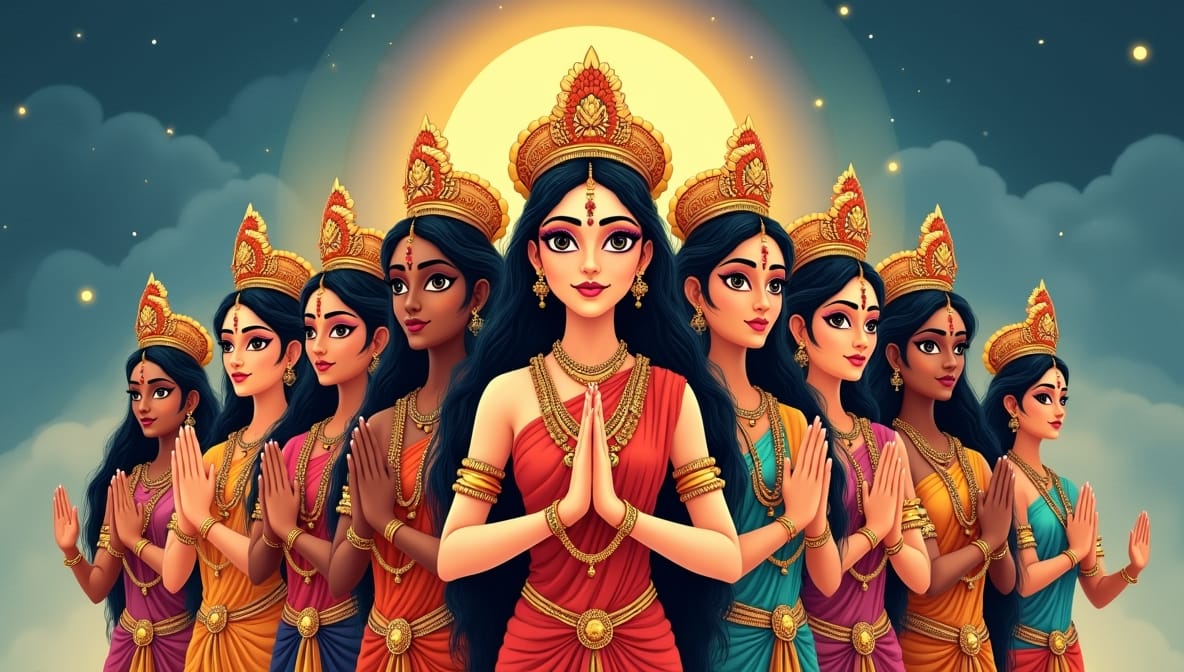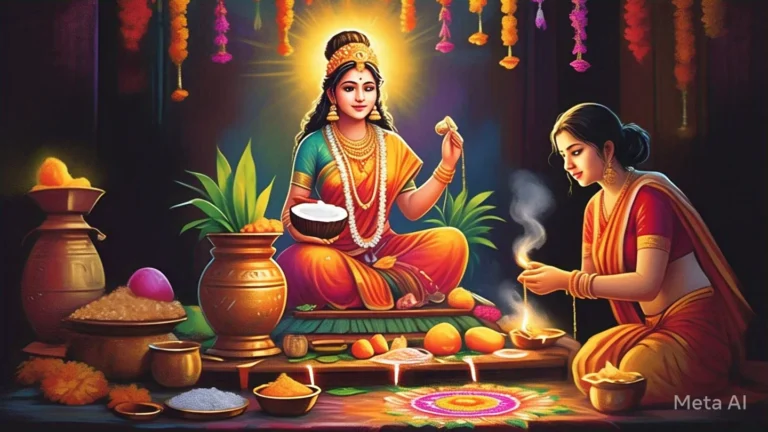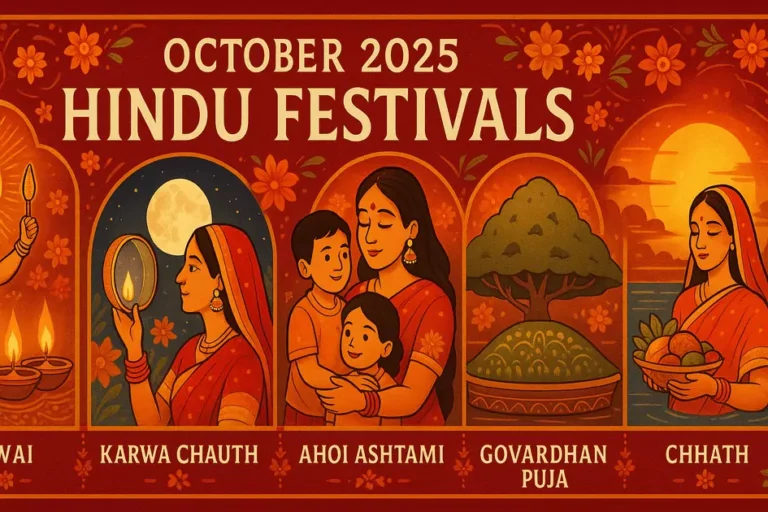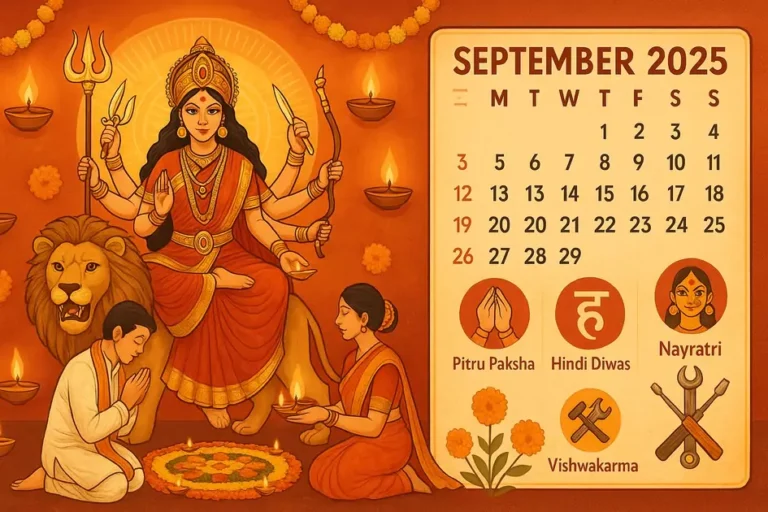
Navratri 2025 Details Dates, Significance, Rituals, and Everything You Need to Know
Navratri, one of India’s most vibrant and spiritually significant festivals, is a nine-night celebration of Goddess Durga’s triumph over evil. In 2025, this grand festival will be observed twice—once in spring as Chaitra Navratri and again in autumn as Sharad Navratri, with the latter being the most widely celebrated. Whether you’re planning to fast, dance the night away with Garba and Dandiya, or simply soak in the divine energy, Navratri 2025 promises to be a time of joy, devotion, and unity. In this detailed guide, we’ll cover everything you need to know about Navratri 2025, from dates and rituals to food and celebrations. Let’s dive in!
What is Navratri?
Navratri, derived from the Sanskrit words “Nav” (nine) and “Ratri” (nights), is a Hindu festival that spans nine nights and ten days. It honors the nine forms of Goddess Durga, collectively known as Navdurga, each representing a unique aspect of divine feminine energy. Celebrated with fervor across India and among the global Hindu diaspora, Navratri symbolizes the victory of good over evil—most famously, Goddess Durga’s defeat of the demon Mahishasura and Lord Rama’s triumph over Ravana. Beyond its spiritual roots, Navratri is a cultural extravaganza, uniting communities through dance, music, fasting, and prayer.
Navratri 2025 Dates
Navratri occurs multiple times a year, but two iterations—Chaitra and Sharad—are the most prominent. Here are the tentative dates for Navratri 2025 based on the Hindu lunar calendar (confirm exact timings with your local panchang closer to the date):
- Chaitra Navratri 2025: March 30 to April 7
- Ends with Rama Navami on April 7.
- Ghatasthapana (pot-establishment ritual) typically begins the festival—check muhurat timings in March 2025.
- Sharad Navratri 2025: September 22 to October 1
- Ends with Dussehra on October 2.
- This is the more widely celebrated Navratri, often simply referred to as “Navratri.”
These dates may shift slightly depending on regional calendars, so stay tuned for updates as 2025 approaches.
The Nine Forms of Goddess Durga (Navdurga)
Each day of Navratri is dedicated to one of the nine forms of Goddess Durga, worshipped for her unique powers and blessings. Here’s a detailed look at the Navdurga:
Day 1: Shailputri
- Meaning: “Daughter of the Mountain” (daughter of Himalaya).
- Symbolism: Strength and determination.
- Color: Orange.
- Offering: Ghee—believed to bring health and vitality.
Day 2: Brahmacharini
- Meaning: The ascetic goddess.
- Symbolism: Wisdom and perseverance.
- Color: White.
- Offering: Sugar—for a sweet, fulfilling life.
Day 3: Chandraghanta
- Meaning: Wears a crescent moon on her forehead.
- Symbolism: Courage and peace.
- Color: Grey.
- Offering: Milk or kheer—for purity.
Day 4: Kushmanda
- Meaning: Creator of the universe.
- Symbolism: Energy and vitality.
- Color: Red.
- Offering: Malpua—for abundance.
Day 5: Skandamata
- Meaning: Mother of Skanda (Kartikeya).
- Symbolism: Nurturing and protection.
- Color: Blue.
- Offering: Bananas—for prosperity.
Day 6: Katyayani
- Meaning: The warrior goddess.
- Symbolism: Courage and justice.
- Color: Yellow.
- Offering: Honey—for sweetness in relationships.
Day 7: Kalaratri
- Meaning: The dark, fierce destroyer of ignorance.
- Symbolism: Fearlessness.
- Color: Green.
- Offering: Jaggery—for cleansing negativity.
Day 8: Mahagauri
- Meaning: The radiant, pure goddess.
- Symbolism: Serenity and forgiveness.
- Color: Pink.
- Offering: Coconut—for fulfillment.
Day 9: Siddhidatri
- Meaning: Bestower of spiritual powers.
- Symbolism: Wisdom and enlightenment.
- Color: Purple.
- Offering: Sesame seeds—for success.
These goddesses are worshipped through prayers, mantras, and offerings, culminating in a powerful spiritual journey over nine days.
Significance of Navratri
Navratri holds deep spiritual and cultural meaning:
- Spiritual Significance: It celebrates the eternal battle between good and evil, with Durga’s victory over Mahishasura symbolizing inner strength and righteousness. For Sharad Navratri, it also ties to Lord Rama’s triumph over Ravana, celebrated on Dussehra.
- Cultural Importance: Navratri unites people through shared traditions—be it fasting in North India or dancing Garba in Gujarat.
- Seasonal Relevance: Chaitra Navratri marks the Hindu New Year in spring, while Sharad Navratri celebrates renewal after the monsoon.
How Navratri is Celebrated Across India
Navratri’s celebrations vary by region, reflecting India’s rich diversity:
- North India: Devotees fast, perform puja, and attend Ram Lila plays depicting Rama’s life.
- Gujarat: Nights come alive with Garba and Dandiya dances, where people don colorful chaniya cholis and ghagras.
- West Bengal: Durga Puja takes center stage with elaborate pandals, idol-making, and immersions on Dashami.
- South India: Families display Golu (tiered doll arrangements) and perform Ayudha Puja, worshipping tools and books.
- Maharashtra: Chaitra Navratri begins with Gudi Padwa, while Sharad Navratri includes fasting and prayers.
Rituals and Traditions
Navratri is steeped in rituals that connect devotees to the divine:
- Ghatasthapana: On Day 1, a clay pot is filled with soil and barley seeds, symbolizing growth and prosperity. It’s placed near a Durga idol or image.
- Fasting: Many observe a strict fast, avoiding grains, onions, garlic, and meat. Allowed foods include fruits, sabudana, and kuttu (buckwheat).
- Kanya Puja: On Day 8 or 9, young girls are worshipped as embodiments of the goddess, offered gifts, and fed prasad.
- Havan: A fire ritual purifies the home and invokes blessings.
- Dussehra: Sharad Navratri ends with Ravana effigy burnings, symbolizing victory over evil.
Navratri 2025 Colors
Each day of Navratri is associated with a color tied to planetary influences. Here’s the traditional sequence (wear these for blessings!):
- Day 1: Orange
- Day 2: White
- Day 3: Grey
- Day 4: Red
- Day 5: Blue
- Day 6: Yellow
- Day 7: Green
- Day 8: Pink
- Day 9: Purple
Navratri Food and Recipes
Fasting doesn’t mean bland meals! Here are some popular Navratri foods:
- Fasting Dishes: Sabudana khichdi, kuttu ki puri, singhara atta halwa, fruit chaat.
- Bhog Offerings: Ghee for Shailputri, malpua for Kushmanda, jaggery for Kalaratri.
- Tips: Use rock salt (sendha namak), avoid regular salt, and skip garlic/onions.
How to Prepare for Navratri 2025
- Cleanse: Purify your home and mind before the festival begins.
- Puja Setup: Arrange a space with Durga’s idol, flowers, and a Ghatasthapana pot.
- Plan: Decide your fasting schedule and pick outfits matching the daily colors.
Navratri Dance and Music
- Garba: A circular dance symbolizing life’s cycle, performed with claps and twirls.
- Dandiya: A stick dance requiring coordination and rhythm.
- Songs: Classics like “Dholi Taro Dhol Baaje” and “Nagada Sang Dhol” set the mood.
- Global Twist: Virtual Garba events connect the diaspora worldwide.
Dussehra 2025: The Grand Finale
- Date: October 2, 2025 (Sharad Navratri).
- Significance: Marks Rama’s victory over Ravana and Durga’s triumph over Mahishasura.
- Celebrations: Effigy burnings, processions, and feasts.
Tips for Celebrating Navratri 2025
- Join local Garba nights or pandal visits.
- Learn dance steps via YouTube tutorials.
- Share greetings: “Happy Navratri 2025! May Maa Durga bless you with strength and joy!”
FAQs About Navratri 2025
Q: When is Navratri 2025?
A: Chaitra Navratri is March 30–April 7; Sharad Navratri is September 22–October 1.
Q: What are the nine goddesses of Navratri?
A: Shailputri, Brahmacharini, Chandraghanta, Kushmanda, Skandamata, Katyayani, Kalaratri, Mahagauri, Siddhidatri.
Q: How do I fast during Navratri?
A: Avoid grains, onions, and meat; eat fruits, sabudana, and kuttu-based foods with rock salt.
Q: What’s the difference between Chaitra and Sharad Navratri?
A: Chaitra occurs in spring and marks the Hindu New Year; Sharad, in autumn, is grander and ends with Dussehra.




